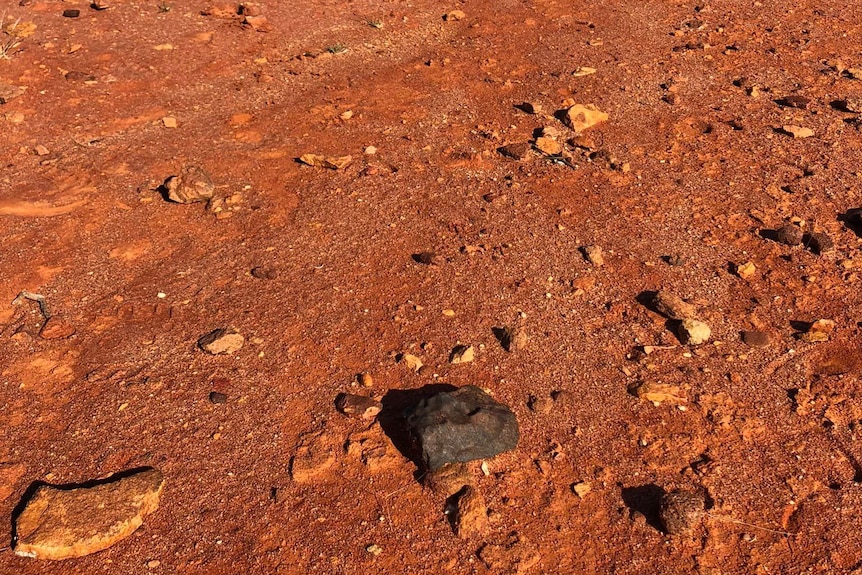AUSTRALIA
Meteorite field found north of Port AugustaABC North and West SA / By Dixie Sulda and Narelle Graham
Posted Yesterday
Scientists uncover a field of meteorites north of Port Augusta.
abc.net.au/news/meteorite-field-found-9-years-after-asteroid-sa-outback/101707426
abc.net.au/news/meteorite-field-found-9-years-after-asteroid-sa-outback/101707426
Scientists have mapped out the fall zone of a six-tonne asteroid that crashed through the atmosphere leading them to a field of meteorites in South Australia.
Key points:A field of meteorites has been located nine years after an asteroid crashed through Earth's atmosphere
The field was discovered along a 6km stretch north of Port Augusta
Some of the meteorites were handed to the SA Museum for a new exhibition
The asteroid landed on Earth in 2013, and was alerted to researchers by defence satellites in the United States.
A "treasure map" was then developed by Curtin University using weather radars and drones that covered a six-kilometre-long stretch north of Port Augusta, leading researchers at Monash University to 44 meteorites in various sizes.
"The guys at Curtin University provided us with a map of where to go and we packed the car … and within about 10 minutes we started picking up meteorites almost straight away," Professor Andy Tomkins from Monash University's School of Earth, Atmosphere and Environment said.
"It's pretty rare for us, we are usually walking around for hours before we find anything."
Key points:A field of meteorites has been located nine years after an asteroid crashed through Earth's atmosphere
The field was discovered along a 6km stretch north of Port Augusta
Some of the meteorites were handed to the SA Museum for a new exhibition
The asteroid landed on Earth in 2013, and was alerted to researchers by defence satellites in the United States.
A "treasure map" was then developed by Curtin University using weather radars and drones that covered a six-kilometre-long stretch north of Port Augusta, leading researchers at Monash University to 44 meteorites in various sizes.
"The guys at Curtin University provided us with a map of where to go and we packed the car … and within about 10 minutes we started picking up meteorites almost straight away," Professor Andy Tomkins from Monash University's School of Earth, Atmosphere and Environment said.
"It's pretty rare for us, we are usually walking around for hours before we find anything."
The meteorites found north of Port Augusta varied in size.(Supplied: Andy Tomkins)
The field of meteorites is the biggest discovery since the Murchison meteorite fall in Victoria in 1969.
"The biggest one [meteorite] we've found so far is about half a kilogram [and] they're down to about 10 grams, so the size of a kangaroo poo — they look a lot like kangaroo poo too," he said.
"You're walking around looking for a rock, which is almost black, sort of dark grey to black in colour, with occasional chips of lighter-coloured stuff shown inside.
"It's quite a distinctive different black colour to everything else that's out there in this particular place."

The field of meteorites is the biggest discovery since the Murchison meteorite fall in Victoria in 1969.
"The biggest one [meteorite] we've found so far is about half a kilogram [and] they're down to about 10 grams, so the size of a kangaroo poo — they look a lot like kangaroo poo too," he said.
"You're walking around looking for a rock, which is almost black, sort of dark grey to black in colour, with occasional chips of lighter-coloured stuff shown inside.
"It's quite a distinctive different black colour to everything else that's out there in this particular place."
Meteorites were located within 10 minutes of researchers arriving at the "likely fall zone".(Supplied: Andy Tomkins)
The asteroid crashed through Earth's atmosphere at 20 kilometres a second, causing the explosion of meteorites.
Samples of the meteorites were provided to SA Museums for a new exhibition.
What now?
Professor Tomkins said the meteorites were cut with a diamond saw, and they were identified as stony meteorites.
A team of biologists is looking at how meteorites are inhabited by microbes straight after they've fallen to Earth.
The asteroid crashed through Earth's atmosphere at 20 kilometres a second, causing the explosion of meteorites.
Samples of the meteorites were provided to SA Museums for a new exhibition.
What now?
Professor Tomkins said the meteorites were cut with a diamond saw, and they were identified as stony meteorites.
A team of biologists is looking at how meteorites are inhabited by microbes straight after they've fallen to Earth.
Scientists are now able to take a closure look at the meteorites.(Supplied: Andy Tomkins)
"Meteorites floating around in space don't have any microbes in them, they're pristine," Professor Tomkins said.
"When they come and land on the earth they're a sample of stuff that's never seen life before.
"So we can look at the minerals that the microbes use to gain energy to get insight into how the earliest processes of the start of the earth's history worked when life was just getting started."
Australian meteorite one of three with key building blocks for life's 'prebiotic soup'
"Meteorites floating around in space don't have any microbes in them, they're pristine," Professor Tomkins said.
"When they come and land on the earth they're a sample of stuff that's never seen life before.
"So we can look at the minerals that the microbes use to gain energy to get insight into how the earliest processes of the start of the earth's history worked when life was just getting started."
Australian meteorite one of three with key building blocks for life's 'prebiotic soup'
No comments:
Post a Comment